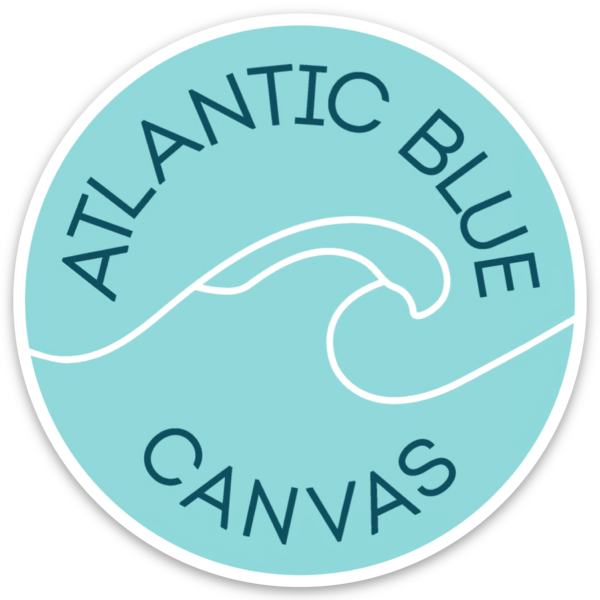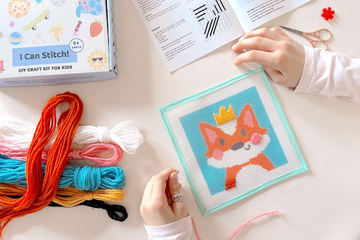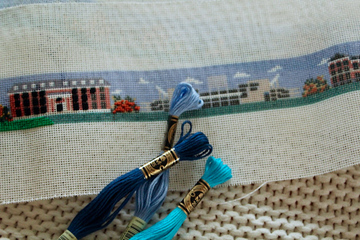Needlepoint has been around for centuries — but it’s making a serious comeback. Once associated with antique samplers and heirloom pillows, needlepoint is now stepping into the spotlight with bold new designs, trendy patterns, and an ever-growing creative community.
If you’ve ever found yourself asking what is needlepoint or how do I get started, you’re in the right place. Whether you’re a curious beginner, a DIY crafter, or someone who loves stylish home decor, this beginner’s guide will walk you through the art of needlepoint from start to stitch.
What Is Needlepoint?
Let’s begin with the basics:
What is needlepoint?
Needlepoint is a form of embroidery where you stitch thread or yarn through a stiff open-weave canvas, creating decorative designs and textured patterns.
Unlike traditional embroidery or cross-stitch, which often use fabric like linen or Aida cloth, needlepoint relies on canvas mesh — often with printed designs — and simple repeated stitches to create colorful works of art. The most common needle point stitch used is the tent stitch, but the possibilities expand from there.
So what is needlepoint used for? Almost anything! Think vibrant throw pillows, framed art, eye-catching ornaments, belts, or custom gifts. Needlepoint is as versatile as it is relaxing.
What You Need to Get Started
The best part about needlepoint? You don’t need much to begin. Here's your starter toolkit:
1. Needlepoint Canvas
-
Available in different mesh counts (like 13 or 18)
-
Designs may be hand-painted or printed
-
The canvas acts as the base you’ll stitch into
2. Thread or Yarn
-
Common materials: wool, silk, cotton, or blends
-
Choose colors based on the design
-
Thicker canvas (lower mesh count) needs thicker threads
3. Tapestry Needles
-
Blunt-ended needles perfect for canvas work
-
Size depends on mesh count and thread thickness
4. Optional Tools
-
Frames or stretcher bars to hold the canvas taut
-
Sharp embroidery scissors
-
Thread organizers or cases
We recommend starting with an all-in-one needlepoint kit to simplify the process — especially our curated beginner needlepoint kits at Atlantic Blue Canvas.
Common Stitches Used in Needlepoint
If you’re wondering what kind of stitches needlepoint involves, don’t worry — you won’t need to memorize hundreds. Most designs rely on a few basic stitches that can be mastered quickly.
1. Tent Stitch
-
The foundational needle point stitch
-
Diagonal stitch worked over one canvas intersection
-
Comes in three variations: half-cross, continental, and basketweave
2. Basketweave Stitch
-
A variation of tent stitch worked in diagonal rows
-
Great for large backgrounds
-
Helps prevent canvas distortion
3. Continental Stitch
-
Similar look to tent stitch, but worked in horizontal or vertical lines
-
Slightly tighter and more secure than half-cross
Each stitch adds texture, depth, and character to your design. Check out our full stitch guide for diagrams and instructions.
Why People Love Needlepoint
So why is needlepoint suddenly everywhere again? Because it delivers something we all crave — calm, creativity, and connection.
1. It’s Meditative
The repetitive motion of stitching can be deeply relaxing — like a screen-free escape from everyday chaos. It’s a form of mindful crafting that encourages presence.
2. Creative Expression
From playful pop culture references to abstract art, needlepoint lets you explore your own style. You can even create custom pieces or collaborate with artists.
3. Home Decor & Personalization
Needlepoint pieces add warmth, texture, and uniqueness to your home. Think: monogrammed ornaments, one-of-a-kind pillows, or stitched wall art.
4. Gifting & Heirlooms
Because it’s made by hand, a needlepoint project carries emotional value. It’s a timeless, heartfelt gift — something that lasts for generations.
Different Styles and Uses of Needlepoint
When people ask what is needlepoint, they’re often surprised by how versatile it can be. Gone are the days of dusty florals — today’s designs are playful, fresh, and full of personality.
Common uses include:
-
Decorative pillows for your couch or bedroom
-
Wall hangings that rival fine art
-
Personalized Christmas stockings and tree ornaments
-
Small items like eyeglass cases, coasters, or belts
Needlepoint Types & Design Styles:
-
Traditional: floral motifs, samplers, geometric borders
-
Modern: pop icons, witty quotes, bold color blocking
-
Coastal: seashells, palm trees, nautical vibes
-
Religious: scripture verses, spiritual symbols
-
Holiday: Santa scenes, festive animals, snowflakes
At Atlantic Blue Canvas, we feature 18+ modern designers whose styles range from nostalgic to cheeky. Whatever your aesthetic, there’s a canvas for you.
Beginner Tips for Getting Started
If this is your first time exploring needlepoint kits, here’s how to set yourself up for success:
1. Start With a Kit
All-in-one beginner needlepoint kits come with a pre-printed canvas, thread, needle, and simple instructions. No guesswork, just stitching.
2. Use Larger Mesh Canvas
Begin with a 13-mesh canvas (larger holes, easier to see) before moving to finer 18-mesh options.
3. Keep It Simple
Choose a small design with few colors and straightforward stitching. This lets you focus on the technique, not the complexity.
4. Don’t Pull Too Tight
Keep tension even and relaxed — tight stitches can distort the canvas or make threading harder.
5. Take Breaks
Your hands (and eyes) will thank you. Needlepoint is meditative, not a race.
Ready to Start Stitching?
Whether you’re looking for a creative outlet or a new hobby that keeps your hands busy and mind calm, needlepoint offers something truly special.
Now that you know exactly what is needlepoint, you’re ready to pick up your first canvas and start stitching a piece that’s entirely yours.
Ready to start stitching? Explore beginner-friendly kits designed with simplicity, joy, and bold style in mind.
Frequently Asked Questions
Is needlepoint hard to learn?
Nope! That’s the beauty of it. While it can get advanced, most beginners can start stitching within minutes. Kits and guides make it even easier.
How is needlepoint different from embroidery?
Embroidery is usually done on softer fabric (like linen) and uses a variety of freeform stitches. Needlepoint uses canvas and structured stitches like tent or basketweave.
What kind of thread should I use?
You can use wool, silk, cotton, or blends — just match it to your canvas mesh size. Most kits come with pre-selected threads that work well.





